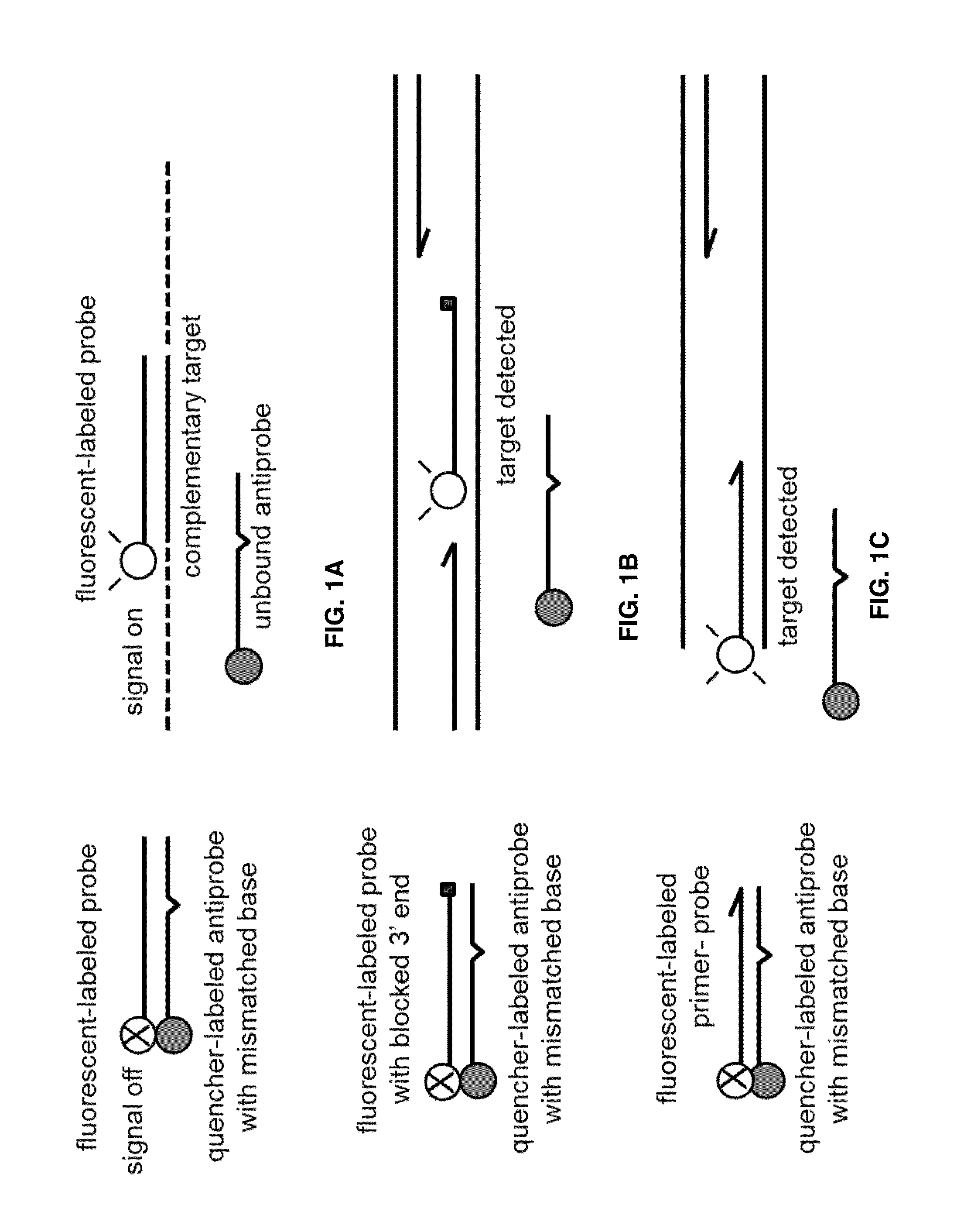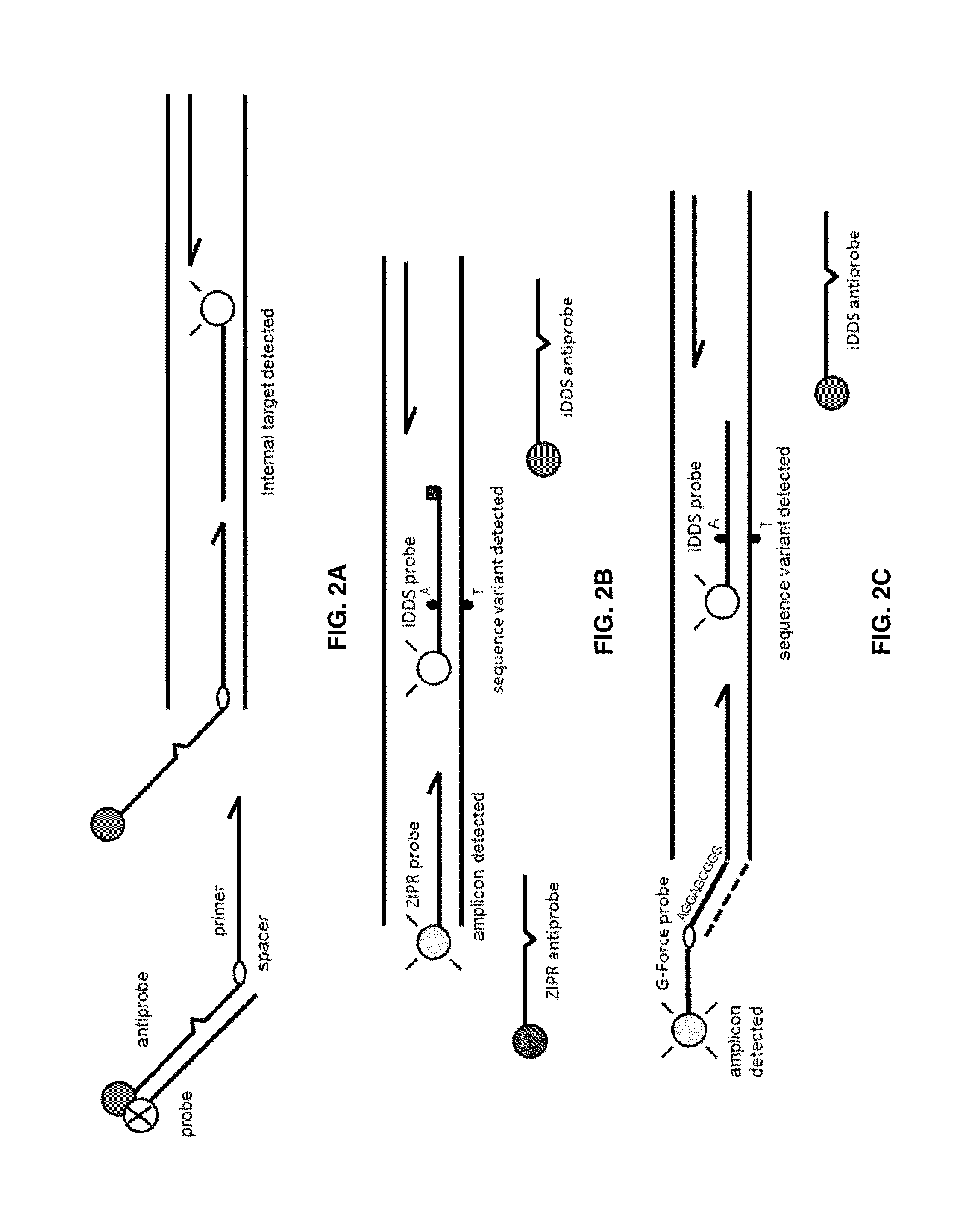Probe:Antiprobe Compositions for High Specificity DNA or RNA Detection
a technology of antiprobes and compositions, applied in the field of nucleic acid probe technology, can solve the problems of difficult synthesis inability to wash, and cost of conventional dual-labeled probes, and achieve the effect of enhancing the amplification and detection of rare sequence variants
- Summary
- Abstract
- Description
- Claims
- Application Information
AI Technical Summary
Benefits of technology
Problems solved by technology
Method used
Image
Examples
example 1
Cycling Conditions
[0154]Real-time PCR was conducted with a Mx4000 instrument (Stratagene, Inc) using HOTSTART-IT PROBE® qPCR master mix (USB, Inc.) (2×) supplemented with 1 ml of 25 mM MgCl2 in a 20 ml reaction. To initiate hot start conditions, the tube was heated to 95° C. for 5 mins followed by 40 cycles of two-step PCR (denaturation at 95° C. for 15 sec, annealing / extension at 58° C. for 1 min). The templates used were ULTRAMER® oligonucleotides (Integrated DNA Technologies, Iowa, USA) comprising the targeted EGFR gene segment with or without the T>G transversion.
example 2
Internal DDS (iDDS) Probe:Antiprobe Compositions to Detect VKORC1 SNP Variants
[0155]An important SNP variant related to warfarin dosing is located in the VKORC1 gene encoding vitamin K epoxide reductase, subunit 1, at the site −1639 thereof, comprising a G>A change in the mutant versus the wild type. To detect these two SNP variants by real-time PCR, the probes, antiprobes and primers below were used at the following final concentrations:
VK-1639G-Probe:(SEQ ID NO.: 1)5′-FAM-CGCACCCGGCCAATG-Phos-3′at 200 nM;VK-1639G-Antiprobe:(SEQ ID NO.: 2)5′-CATCGGCCGGGTGCG-BHQ1-3′at 400 nM;VK-1639A-Probe:(SEQ ID NO.: 3)5′-FAM-ATTGGCCAGGTGCG-Phos-3′at 200 nM;VK-1639A-Antiprobe:(SEQ ID NO.: 4)5′-CGCACCTGGCCTAT-BHQ1-3′at 400 nM;VK-Forward primer:(SEQ ID NO.: 5)5′-CCTCTGGGAAGTCAAGCAAG-3′at 200 nM;andVK-Reverse primer:(SEQ ID NO.: 6)5′-AAATGCTAGGATTATAGGCGTGA-3′at 200 nM
[0156]While the probes and antiprobes contain the targeted single base variants for VKORC1, each antiprobe was modified with a mismatc...
example 3
Internal DDS (iDDS) Probes for Real Time PCR Detection of a Single Base Variant of the EGFR Gene (at Exon 21 L858R) Associated with Lung Cancer Diagnosis and Therapy
[0161]To detect the EGFR Exon 21 mutant codon L858R suspected of being present in a nucleic acid sample, and possibly in the presence of the 858L wild-type (normal) codon sequence, the following oligonucleotide probes, antiprobes and PCR primers were synthesized and used at the indicated final concentrations:
EGFR 858R probe:(SEQ ID NO.: 7)FAM-CAGATTTTGGCCGGGCCAAACTG-Phos at 200 nM;EGFR 858R antiprobe:(SEQ ID NO.: 8)CAGTTTGGCCCGCCCAATATCTG-BHQ1 at 400 nM;EGFR 858L probe:(SEQ ID NO. 9)CalRed610-CAGATTTTGGGCTGACCAAACTG-Phos at 200 nM;EGFR 858L antiprobe:(SEQ ID NO.: 10)CAGTTTGGCCAGCCCATAATCTG-BHQ2 at 400 nM;Forward primer:(SEQ ID NO.: 11)GAAAACACCGCAGCATGTC at 200 nM;andReverse primer:(SEQ ID NO.: 12)CTGCATGGTATTCTTTCTCTTCC at 200 nM.
[0162]While the above probes and antiprobes contain the targeted single base variants at co...
PUM
| Property | Measurement | Unit |
|---|---|---|
| Tm | aaaaa | aaaaa |
| temperatures | aaaaa | aaaaa |
| temperatures | aaaaa | aaaaa |
Abstract
Description
Claims
Application Information
 Login to View More
Login to View More - R&D
- Intellectual Property
- Life Sciences
- Materials
- Tech Scout
- Unparalleled Data Quality
- Higher Quality Content
- 60% Fewer Hallucinations
Browse by: Latest US Patents, China's latest patents, Technical Efficacy Thesaurus, Application Domain, Technology Topic, Popular Technical Reports.
© 2025 PatSnap. All rights reserved.Legal|Privacy policy|Modern Slavery Act Transparency Statement|Sitemap|About US| Contact US: help@patsnap.com



